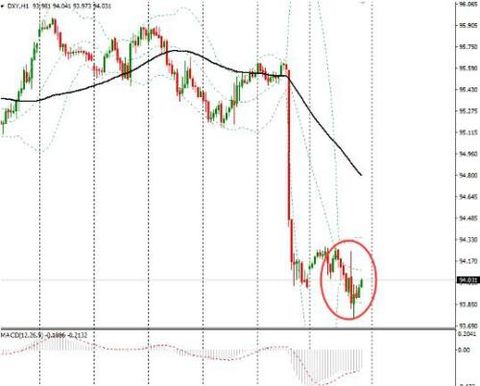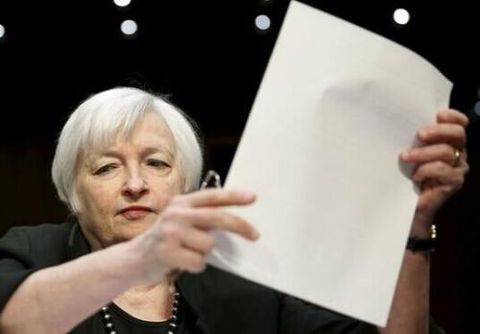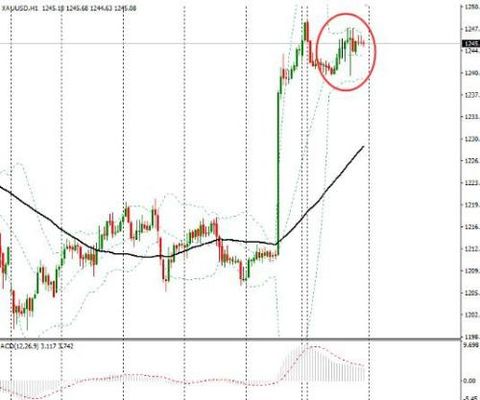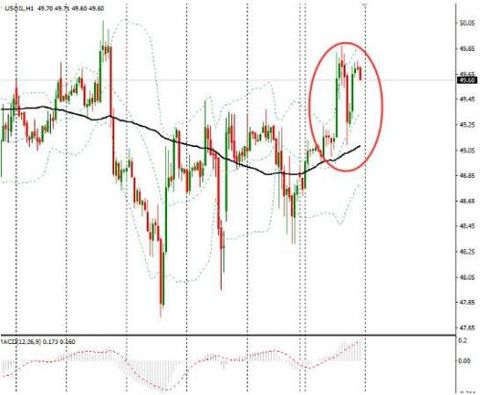The US dollar recuperates the interest supply and interrupts the oil price.
Challenge the whole network to earn 7% in the last 7 days! Ultra-short-term financial management seven-day treasure first 10% off the purchase of E Fund Gold Fund
On Monday (June 6), after the weak US non-agricultural data was released last week, the market is eager to find out from the mouth of Fed Chair Yellen whether there will be any changes in the outlook of the Fed policy. However, the savvy President Yellen played Tai Chi again and still avoided giving specific policy forecasts. After a sharp fall last week, the dollar oscillated in the market on Monday. In terms of crude oil, although the US rigs increased significantly last week, supply disruptions at the beginning of this week have risen in the market, and oil prices still face strong resistance. In this context, oil prices finally closed up 2%.
In the specific market, the US dollar index fluctuated near the 94 mark, the Federal Reserve Yellen did not give clear information to raise interest rates; the euro against the US dollar volatility trading near 1.1350, the euro zone political risk pressured the euro; gold price held steady at a two-week high Below, after the weak non-agricultural market last week, the price of gold temporarily suspended; oil prices rose 2%, driven by supply concerns for three consecutive days, Yellen speech after the oil price increased shocks, and eventually closed higher.
The US dollar index oscillated near the 94 mark, and the Federal Reserve Yellen did not give a clear rate hike. On the same day, other Fed officials issued a gradual rate hike to raise interest rates, while the US economic data did not perform well.
The Federal Reserve Yellen spoke and played Tai Chi. Federal Reserve Chairman Yellen spoke on the Philadelphia World Affairs Council on economic prospects and monetary policy on Monday. Yellen stressed that a strong economy means that interest rate hikes are still possible, and positive factors in the US economy have overshadowed negative factors, but The employment report on Friday was disappointing and should not be too focused on the report itself.
After the US federal funds rate futures showed Yellen’s speech, traders expected the Fed’s rate hike in June to rise slightly to 5.6%, 3.9% before the speech, and the rate hike in July rose to 37.4%, 34.6% before the speech.
Yellen’s tone was tight, and the clues to the timing of the next rate hike were not revealed, which was very different from the speech on May 27. Yellen’s speech is the last public speech delivered by Fed officials before the Federal Reserve’s monetary policy meeting next week. She did not give any other hints about the timing of the rate hike.
Tom Porcelli, principal analyst at RBC Capital Markets, said, "Yellen may not have imagined such a dove, but her speech is unbiased. Today's mixed signal indicates that Yellen is not inclined to take action, that is, in the recent interest rate normalization process The next step, but did not close the door to raise interest rates in July."
Omar Esiner, chief market analyst at Commonwealth Foreign Exchange, said, "Yellen did not mention the timing of the rate hike. I think this only excludes the possibility of a rate hike in June. If data cooperation, it is possible to raise interest rates in July. In this respect, she is more optimistic than Wall Street and I think, this is my main interpretation of her speech today."
The weak US non-farm payrolls report released last Friday made investors rule out the possibility of the Fed raising interest rates in June. The US Labor Department said on Friday that the number of non-agricultural jobs increased by only 38,000 last month, the smallest increase in more than five and a half years, far less than the market estimate of 164,000. Investors almost ruled out the possibility of the Fed raising interest rates at the June 14-15 meeting. As concerns about Brexit are also accumulating, investors are increasingly uncertain whether the Fed will raise interest rates in the near future.
Dollar index hourly chart display

The specific content of the Fed’s speech. Federal Reserve Chairman Yellen said that the US employment report in May was disappointing and worrying, and did not over-interpret the one-month data, and other labor market indicators were more positive. Economic positive factors outweigh negative factors. If the conditions are met, a gradual rate hike may be appropriate. The job market situation is very favorable, and its restrictions have basically been eliminated, and salary growth may eventually accelerate.
In terms of monetary policy, Yellen pointed out that there is no default path for monetary policy, and the current monetary policy posture is generally appropriate and slightly loose. In the normal economy, higher interest rates are appropriate and the current normal interest rate is quite low. It believes that the neutral interest rate will rise in time, and interest rates will gradually increase, but no exact time is given. Only in rare cases will the Fed give special guidance and have repeatedly stated that there is no default path for interest rates. What the Fed can do is to explain what factors influence the interest rate path. The Fed continues to respond to new data. Special guidance is appropriate in major crises, but the era of special interest rate guidance is an abnormal period.
In terms of inflation, Yellen expects the inflation rate to rise to 2% over time. Unless oil prices return to a earlier decline, or the dollar continues to climb, inflation will rise to 2% in the next one to two years. For the Fed, the trend of crude oil and dollar prices is unpredictable.
In terms of external risks, Yellen said that China's economic restructuring is facing considerable challenges. It is well known that China faces many challenges in shifting the economy to rebalancing domestic demand and consumption. The British vote to leave the EU may have a huge response. Yellen stressed that he is cautiously optimistic that the overseas resistance facing the US economy is gradually receding.

In addition to Yellen, other Fed officials issued interest rate remarks. On Monday, the three Fed officials of the Federal Reserve, Brad, the voting committee, Rosengren and Lockhart, all expressed their comments on the gradual rate hike in the future, but they basically ruled out the possibility of raising interest rates in June.
The more neutral vote of the US St. Louis Fed chairman, Brad, pointed out that the Fed’s gradual rate hike is appropriate. The slowdown in monthly employment growth data is acceptable. The employment data for May is indeed a regrettable accident. It seems that the era of employment growth of 200,000 per month is over. Although corporate recruitment was weak in May, the labor market is still very strong. The Fed’s rate hike should be based on a good economic situation. It is open to the results of the June FOMC meeting and will not be prejudged.
Rosengren, the voter of the Boston Fed President's Dove, also issued a rate hike. He said that economic growth is expected to be sufficient to support a gradual rate hike. There is evidence that inflation is moving towards the 2% target, and the May employment report is disappointing. Despite the recent mixed data, monetary policy should gradually tighten and the US is currently at its estimated full employment level. Optimistic about US retail sales and consumption, the Fed is getting closer to an environment that can raise interest rates.
The chairman of the Federal Reserve Bank of Atlanta, who has no voting rights this year, said that the Fed will raise interest rates twice during the year. Future policy decisions still depend on data, and business investment is being affected by uncertainty. Despite the poor employment data in May, their views on the economy have not changed, and employment data may reflect a slowdown in employment under full employment. The US economy is still growing moderately, and the Fed is watching how things will develop in the coming weeks, and the Fed policy will continue to stimulate the economy.
The market is predicting the Fed’s interest rate hike prospects. "Fed News Agency" Hilson Lat believes that the June 14-15 meeting is almost certainly not talking about raising interest rates. The possibility of a rate hike in July is there, but this possibility is small because Fed policymakers will not get more economic data to re-establish the economy. Some officials are more likely to wait until the September meeting to consider raising interest rates, provided that the US economy has risen this summer.
Societe Generale Kit Juckes believes that the Fed will not raise interest rates before the end of the election. The bank believes that the latest US non-agricultural data points to a large range of economic weakness, although the employment participation rate has increased at the beginning of this year, but the data is easy to fall in the summer, or the market can be based on household sub-item data is not as reliable as the enterprise sub-item Neglect; the current bottom line is that the GDP growth rate in the second quarter is still around 2%, but it also shows signs of lack of motivation. The Fed has no doubt added another obstacle before raising interest rates before the election.
Nomura exchange rate strategist Yujiro Goto said, "The expectations for interest rate hikes in June have dissipated. As the focus shifts to the July meeting, we expect the dollar to be sluggish as the US will not release too much data this week. The euro is expected to be in the US dollar. 1.10-1.15 interval."
The US Job Market Status Index released on Monday did not perform well. The specific data shows that the US employment market condition index (LMCI)-4.8 in May, expected -0.8, the previous value -0.9 was revised to -3.4.
According to the analysis, the US job market condition index fell by 4.8 in May, recording the biggest monthly decline in the five-month decline. The market expects the index to fall in May, but the latest data so rapid decline is really worrying.
The euro oscillated around the 1.1350 against the dollar, and the euro zone's political risk put pressure on the euro. European Central Bank officials published dovish remarks, and the euro zone economic data was mixed on Monday.
Eurozone political risk is putting pressure on the euro. KBC strategist Piet Lammens said, "A survey shows that the UK's Brexit camp is leading, and the Italian five-star movement is rising again, so political risk is a very important issue."
The first is that the UK may leave the EU's concerns. Concerns that the UK may leave the EU dragged the euro against the dollar. With the approach of the British “Brexit†referendum on June 23, the uneasiness surrounding the possible retreat of the UK is also heating up. According to the results of the online poll conducted by ICM and YouGov on Monday, the Brexit camp is 4-5 percentage points ahead, which pushes the pound to a three-week low.
Second, the Italian government was frustrated in the municipal elections. The “five-star movement†of the Italian anti-institutional political party performed well in local elections over the weekend, deepening the concerns of European political risks.
The "five-star movement" seems to take the election of the mayor of Rome and put pressure on Prime Minister Renzi. In the local elections held on Sunday, the party also made some gains in other cities. The party actively advocated against corruption, and its victory also reflected the rising power of anti-institutional parties throughout Europe.
European Central Bank officials published dovish remarks. European Central Bank governor Likanin and management committee Marcus expressed on Monday that the euro zone inflation is still weak. Likanin said that price and inflation in the euro zone are still suppressed, and long-term inflation expectations in the euro zone are still too low. Marcus expects the Eurozone inflation rate to be negative at the end of the year.
EUR/USD hourly chart

In terms of economic data, economic data in the euro zone on Monday was mixed. Eurozone confidence index data was better than expected, but German factory orders data was weak.
Specific data shows that the Eurozone Sentix investor confidence index of 9.9 in June, expected 7, the previous value of 6.2, the highest since the beginning of this year. According to the analysis, the Sentix investor confidence index rose to a high this year in June, indicating that investors have eliminated concerns about the global economy since the beginning of this year; Hutner, head of research at Sentix, said investors were boosted by recent strong data. Its confidence has increased; ECB policymakers are waiting to implement further monetary policy measures.
In addition, the weak German data showed that Germany's factory orders in April were adjusted to a monthly rate of -2.0%, expected -0.5%, the previous value of 2.6%; after the working day adjustment, the factory order annual rate -0.5%, expected 0.6%, the previous value 2.4%.
The price of gold remained steady at a two-week high. After last week's weak non-agricultural price, the price of gold temporarily closed. Gold prices rose to a two-week high on Monday, and then retreated some of last Friday's gains, holding steady after Fed Chair Yellen delivered a speech.
Spot gold rose 0.02% to $1,244.31 per ounce, rising to the highest of $1,248.40 since May 24; spot silver rose 0.1% to $16.42 per ounce.
Yellen said that raising interest rates is possible because the US “positive factors of the economy outweigh the negative factorsâ€, but the weak employment report deserves attention. The price of gold jumped 2.8% last Friday, as the non-agricultural employment report released by the US on the same day was unexpectedly weak, which caused the United States to drop interest rates in the near future. Before Yellen’s speech, the survey showed that major banks on Wall Street unanimously expected the Fed to keep interest rates unchanged this month.
Federal Reserve Governor Leonard urged the bank's governors to wait for more economic data on Friday before considering the issue of raising the benchmark interest rate. Atlanta Federal Reserve Chairman Lockhart said on Monday that he would not support the Fed to raise interest rates at a policy meeting to be held later this month, but is open to the prospect of a rate hike in July. Two other Fed officials, St. Louis Fed President Brad and Boston Fed President Rosen Glenn also believe that the Fed will continue to raise interest rates gradually during the year.
Spot gold price hourly headlines

Tai Wong, head of basic and precious metals trading at BMO Capital Markets, said, “President Yellen’s handling is very subtle, which emphasizes positive factors and acknowledges the recent weak employment, which makes the price of gold and other markets basically the same, which she might have been for this purpose. This keeps the possibility of a rise in the July meeting, and the focus shifts to the dot pattern of June."
Royce Mendes, senior analyst and director of CIBC Capital Markets, said: "The employment report did not dispel the Fed’s desire to raise interest rates later this year, but considering the recent volatility of the data, it is still expected that the path to raise interest rates will be very slow, we still expect The Fed raised interest rates in September."
After Yellen’s speech, Adam Koos, president of wealth management company Libertas Wealth Management Grou, said, “Yellen is playing 'guessing games’ with market participants, so that bullish and bearish people are not sure about the next rate hike. The specific time. Of course, one thing that is well known is that the Fed will be forced to make policy decisions, whether or not it is supported."
The world's largest gold exchange-traded fund (ETF) - SPDR Gold TrustGLD gold positions rose on Friday to the highest since October 2013.
Oil prices rose 2%, driven by supply concerns for three consecutive days. After Yellen’s speech, oil prices intensified and eventually closed higher. Oil prices rose for the third day on Monday, as the Nigerian oil industry was hit and production was cut, and US crude oil inventories fell again. After Yellen’s speech, the price of oil increased and fluctuated, but eventually closed higher.
Brent crude oil futures closed up 0.91 US dollars, or 1.8%, to $50.55 a barrel, hitting a maximum of $50.83 since November last year. US crude oil futures climbed $1.07, or 2.2%, to $49.69 a barrel, the largest single-day percentage gain since May 16. Brent crude oil futures hit a seven-month high and closed up 1.8%. US crude oil futures closed up 2.2%, the biggest one-day gain in three weeks.
Worries about supply disruptions support oil prices. Attacks by Nigerian militants continue to cause the country’s crude oil supply to be affected. Industry sources said that due to the attack on infrastructure such as oil pipelines, it is estimated that the production of light oil in Berne, Nigeria, fell by 170,000 barrels per day, and the total oil production in the country fell by more than 500,000 barrels per day. Affected by this, oil prices rose.
ICAP energy broker Scott Shelton said, “At present, there is no sign of improvement in Nigeria and it seems to be worse.â€
INTL FCStone analyst Edward Meir pointed out in a research report released on Sunday that the widespread forest fires in Canada last month caused the country's production to drop by 800,000 barrels per day to 1 million barrels per day. The proportion of total production in Alberta is about 40%. Although the fire has subsided, it will take weeks or months for oil companies to resume full operations.
US crude oil price hourly chart shows

Worries about reduced crude oil inventories support oil prices. In addition, according to traders who saw the data, market information company Genscape reported that as of June 3, the crude oil inventories of Cushing, the US crude oil futures delivery, decreased by 1.08 million barrels, supporting the rise in oil prices. The survey shows that analysts expect US crude oil inventories to drop by 3.5 million barrels in the third week last week.
After Fed Chair Yellen’s speech, Brent and US crude oil futures intensified, but oil prices eventually closed higher. Yellen said that despite the disappointing data on non-farm payrolls in May, it is expected that this year will gradually raise interest rates.
ClipperData's crude oil analyst Troy Vincent said, "As with most traders, crude oil dealers are also trying to find out what is the truth, and which are just the Fed's official words. The market should have expected Yellen. I will be optimistic and try to belittle the importance of the non-farm payrolls report on Friday, but the real question now is what does this mean for the Fed’s rate hike?â€
Yellen’s speech made the dollar more volatile, while the oil market traders’ cautious sentiment remained. Any short-term gains in the dollar will increase the cost of buying dollars in crude oil for investors holding other currencies. Traders said that if speculation about raising interest rates in the United States heats up, the dollar may rise in the next few days, which will put pressure on oil prices.
In addition, oilfield service provider Baker Hughes Inc. announced on Friday that the number of active crude drilling platforms in the United States increased by nine last week, the first increase in 11 weeks. Some analysts have pointed out that they are worried that the recent rise in oil prices may lead to a sharp increase in production.
Citibank believes that the crude oil market will be rebalanced between supply and demand in the middle of this year, and crude oil supply will not be needed for most of the next six quarters. Previously, Citi expected that oil will continue to be above $50/barrel in the third quarter and $65/barrel by the end of 2017.
Morgan Stanley analysts pointed out that crude oil and natural gas investment has fallen sharply in the past two years, so crude oil and natural gas may not meet market demand in the future. The investment in the past two years has decreased, and it is difficult to judge whether it will lead to insufficient supply of crude oil and natural gas, but the bank believes that the situation of short supply may occur.
Salad Bowl,Handmade Nice Salad Bowl,Anti-Bacterial Salad Bowl,Simple Salad Bowl
shaoxing qinzi business company ltd , https://www.qinzisx.com